[FULL DISCLOSURE: I received my copy of this book free from the author. I was not paid for this review and the opinion expressed is purely my own]
Every time I think that nothing more can be written about WWII that is both interesting and informative a book like this one makes an appearance. I will even be upfront and admit that I don’t normally go in for biographies or autobiograhies of famous people, much less someone who is not a household name. Nightfighter: Radar Intercept Killer by Mark A. Magruder has caused me to reevaluate both opinions.

This book is the story of USMC COL Marion Magruder, one of the most influential people in the development and implementation of Marine Corps Nightfighter doctrine in WWII. COL Magruder is one of those figures that had a profound impact on the war but who almost nobody has heard about because they were not glory hounds out to make a name for themselves. COL Magruder just wanted to win the war, do his job, and bring as many of his people home as he could. The book is written by one of the COL’s sons and is a tribute to him. It succeeds in being both an excellent tribute and a great chronicle of a little understood of aspect of WWII aerial combat.
The book itself is 286 pages of text with a reference list and index. It is divided into twelve topical chapters that detail the story of COL Magruder’s career from inception in the Marine Corps to the end of WWII.
The most interesting part of this story is the revelation that at the outset of WWII the USMC had no doctrine for nightfighting and had virtually ignored that aspect of aerial combat. It was only in the face of nighttime Japanese raids and the damage they caused that the Marines decided to develop that capability. COL Magruder was part of a team deployed to England to learn nightfighting and practice it against the Germans in a crash course before returning to the states and writing Marine nightfighting doctrine. He then went on to stand up, command, and take to combat VMF(N) 533, one of the first nightfighting squadrons for Marine Aviation.
This work is the story of the man behind the development and successful implementation of Marine nightfighting in WWII. It is engagingly written, well presented, and a joy to read. I highly recommend this book for anyone interested in WWII but especially for aviation historians for the glimpse into the ways doctrine is developed and implemented under the pressures of war.

